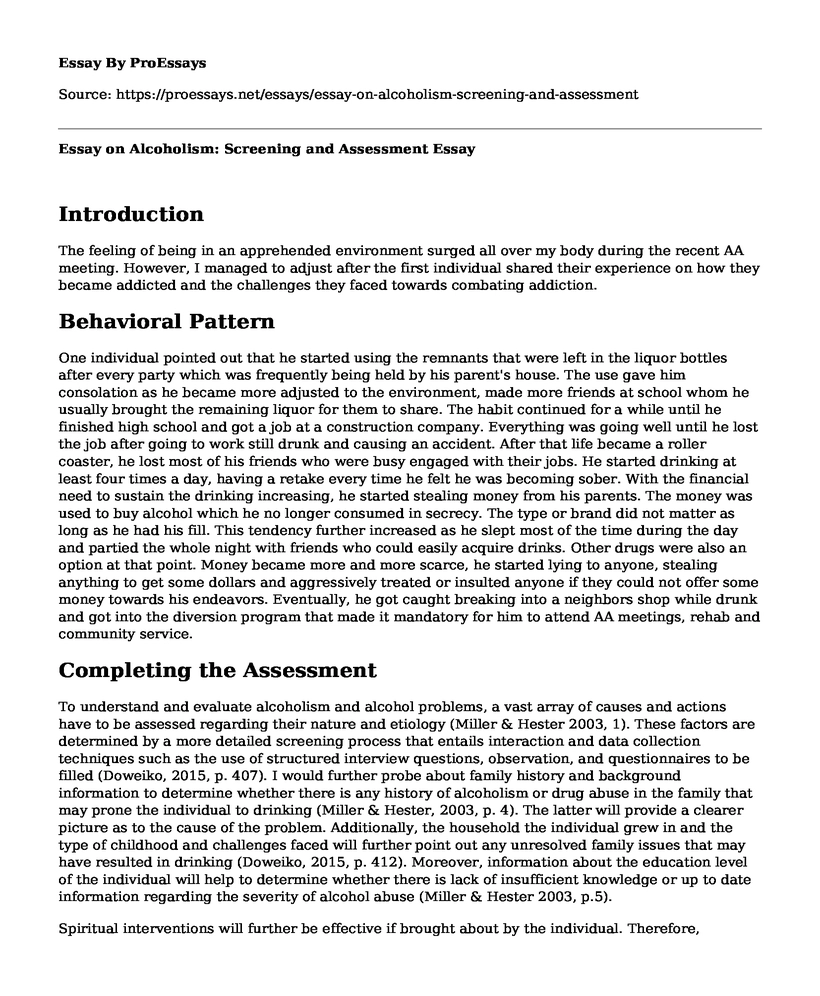Introduction
The feeling of being in an apprehended environment surged all over my body during the recent AA meeting. However, I managed to adjust after the first individual shared their experience on how they became addicted and the challenges they faced towards combating addiction.
Behavioral Pattern
One individual pointed out that he started using the remnants that were left in the liquor bottles after every party which was frequently being held by his parent's house. The use gave him consolation as he became more adjusted to the environment, made more friends at school whom he usually brought the remaining liquor for them to share. The habit continued for a while until he finished high school and got a job at a construction company. Everything was going well until he lost the job after going to work still drunk and causing an accident. After that life became a roller coaster, he lost most of his friends who were busy engaged with their jobs. He started drinking at least four times a day, having a retake every time he felt he was becoming sober. With the financial need to sustain the drinking increasing, he started stealing money from his parents. The money was used to buy alcohol which he no longer consumed in secrecy. The type or brand did not matter as long as he had his fill. This tendency further increased as he slept most of the time during the day and partied the whole night with friends who could easily acquire drinks. Other drugs were also an option at that point. Money became more and more scarce, he started lying to anyone, stealing anything to get some dollars and aggressively treated or insulted anyone if they could not offer some money towards his endeavors. Eventually, he got caught breaking into a neighbors shop while drunk and got into the diversion program that made it mandatory for him to attend AA meetings, rehab and community service.
Completing the Assessment
To understand and evaluate alcoholism and alcohol problems, a vast array of causes and actions have to be assessed regarding their nature and etiology (Miller & Hester 2003, 1). These factors are determined by a more detailed screening process that entails interaction and data collection techniques such as the use of structured interview questions, observation, and questionnaires to be filled (Doweiko, 2015, p. 407). I would further probe about family history and background information to determine whether there is any history of alcoholism or drug abuse in the family that may prone the individual to drinking (Miller & Hester, 2003, p. 4). The latter will provide a clearer picture as to the cause of the problem. Additionally, the household the individual grew in and the type of childhood and challenges faced will further point out any unresolved family issues that may have resulted in drinking (Doweiko, 2015, p. 412). Moreover, information about the education level of the individual will help to determine whether there is lack of insufficient knowledge or up to date information regarding the severity of alcohol abuse (Miller & Hester 2003, p.5).
Spiritual interventions will further be effective if brought about by the individual. Therefore, bringing the aspect of faith and God by asking whether the individual believes he has a firm belief and what role has God played in their quest to quit drinking will determine whether he views drinking as a temptation that is wrong. Further gathering knowledge on individual perspective towards drinking with to spiritual believes (Clinton and Scalise, 2013, p. 163). I will also need to understand the medical and psychiatric treatment history of the individual to determine the level of health and medical issues that can be addressed adequately in the treatment plan (Doweiko, 2015, p. 412. Moreover, I will inquire to find out the individuals perspective towards drinking as a moral factor as alcohol is considered a moral or criminal issue in the society. The latter will inform consideration of individual's perspective in the treatment plan (Miller & Hester 2003, p.2).
Conclusion
Understanding individuals history, family relations, medical history and perspectives towards alcoholism will enable in diagnosing the problem further and tailoring of an effective treatment plan. The latter is fundamental as consequences, issues and causes of alcohol use and addiction vary from person to person.
References
Clinton, T., & Scalise, E. (2013). The quick-reference guide to addictions and recovery counseling: 40 topics, spiritual insights, and easy-to-use action steps. Grand Rapids, MI: Baker Books.
Doweiko, H. E. (2015). Concepts of chemical dependency - Text only (9th ed.). Stamford, CT: Cengage.
Hester, R. K., & Miller, W. R. (2003). Handbook of alcoholism treatment approaches Effective alternatives. Third Edition. Pearson Education, Inc
Cite this page
Essay on Alcoholism: Screening and Assessment. (2022, Jul 25). Retrieved from https://proessays.net/essays/essay-on-alcoholism-screening-and-assessment
If you are the original author of this essay and no longer wish to have it published on the ProEssays website, please click below to request its removal:
- Paper Sample on Dangers of Speeding
- Anti-bias Curriculum: Communication With People With Disability
- Social Work Practice and Health Care Access Among Hispanic Immigrants
- Debates Surrounding Banning of Cellphones While Driving
- Essay Sample on Inequality in America: The Rich vs. Poor Divide
- Essay Sample on Gidget's Story: Unfairly Denied Recognition for Her Surfing Skill Due to Gender Bias
- The Economics of Income Inequality: Exploring Different Sources of Income - Essay Sample







